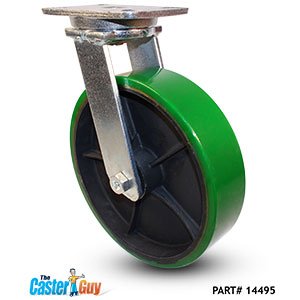
Swivel Caster with 12 Inch Wheel
When it comes to choosing the right casters for your equipment, one of the most common questions is whether bigger casters roll better. At The Caster Guy, we understand that selecting the right caster can make a significant difference in performance, safety, and efficiency. In this guide, we’ll explore the factors that influence caster performance and whether bigger casters are indeed better.
Understanding Caster Dynamics
Casters are complex components designed to facilitate movement and support loads. The performance of a caster is influenced by several factors including size, material, load capacity, and the surface on which it is used. Let’s break down these factors to understand their impact:
Size and Rolling Efficiency
One of the primary considerations is the size of the caster wheel. Generally, larger wheels tend to roll more easily over obstacles and uneven surfaces. This is because larger wheels have a reduced rolling resistance and can distribute weight more evenly, reducing the effort required to move heavy loads.
For example:
- Larger wheels can roll over small debris and cracks that might stop smaller wheels.
- Bigger casters can reduce the force needed to start and maintain movement.
Material and Surface Interaction
The material of the caster wheel also plays a crucial role in its performance. Casters come in various materials including rubber, polyurethane, steel, and plastic. The choice of material should depend on the surface and the type of load.
Considerations include:
- Rubber casters offer good grip and shock absorption, making them ideal for rough or uneven surfaces.
- Polyurethane casters are durable and provide a smooth ride, suitable for hard surfaces.
- Steel and plastic casters are best for environments where they won’t damage the floor and are typically used for lighter loads.
Load Capacity
Another critical factor is the load capacity of the caster. Bigger casters generally have a higher load capacity, which means they can support heavier weights without deforming or failing. However, it’s essential to choose casters that are rated for the specific load they will carry.
Key points include:
- Ensuring the caster can support the total weight of the equipment plus any additional load.
- Distributing weight evenly across multiple casters to avoid overloading a single caster.
Benefits of Bigger Casters
Now that we understand the factors influencing caster performance, let’s explore the specific benefits of using bigger casters:
Smoother Movement
Bigger casters can navigate over obstacles and uneven surfaces more smoothly than smaller ones. This is particularly beneficial in industrial settings where floors may have cracks, debris, or other irregularities.
Reduced Effort
With larger wheels, the amount of force required to start and maintain movement is significantly reduced. This can lead to less strain on workers and improved efficiency in moving equipment.
Higher Load Capacity
As mentioned earlier, bigger casters can support heavier loads, making them ideal for heavy-duty applications. This reduces the risk of caster failure and ensures safer operation.
Longevity
Larger casters tend to have a longer lifespan because they distribute weight more evenly and are less likely to wear out quickly. This means fewer replacements and lower maintenance costs over time.
When Bigger Casters May Not Be Ideal
While bigger casters offer numerous benefits, there are situations where they may not be the best choice:
Space Constraints
In environments with limited space, larger casters may not be practical as they require more room to maneuver. Smaller casters might be a better fit in such cases.
Weight Considerations
Bigger casters can add significant weight to the equipment. In applications where weight is a critical factor, such as in mobile medical devices, smaller and lighter casters might be preferred.
Cost
Larger casters are generally more expensive than smaller ones. If budget constraints are a concern, it’s important to weigh the cost against the benefits to determine the best option for your needs.
Conclusion
At The Caster Guy, we believe that the right caster choice depends on the specific requirements of your application. While bigger casters often roll better and offer numerous advantages such as smoother movement, reduced effort, higher load capacity, and longer lifespan, it’s essential to consider factors like space constraints, weight, and cost.
By understanding these dynamics and evaluating your needs, you can make an informed decision that enhances the performance and efficiency of your equipment. If you have any questions or need assistance in selecting the right casters, our experts at The Caster Guy are here to help. Contact us today for personalized guidance and high-quality caster solutions.

